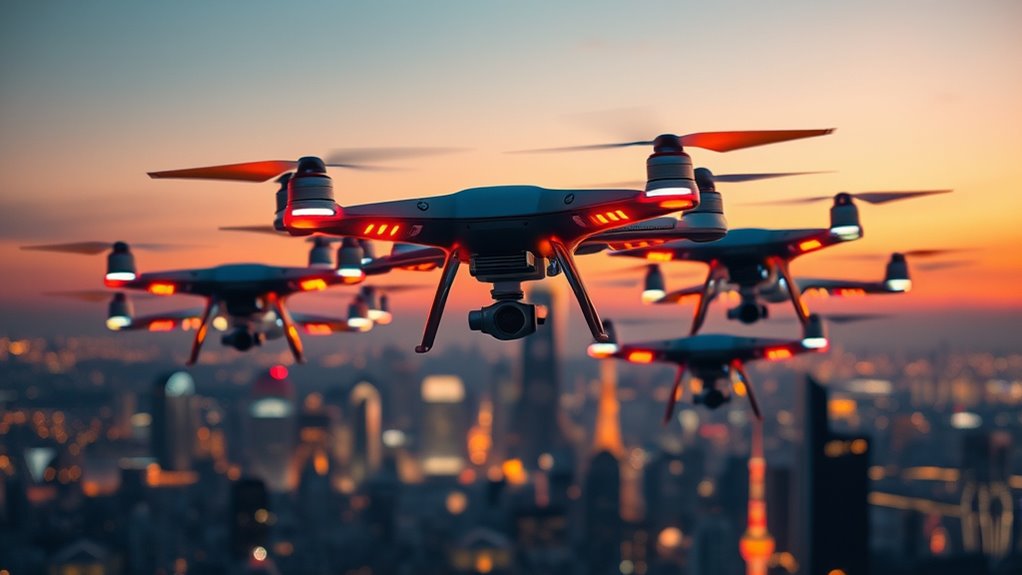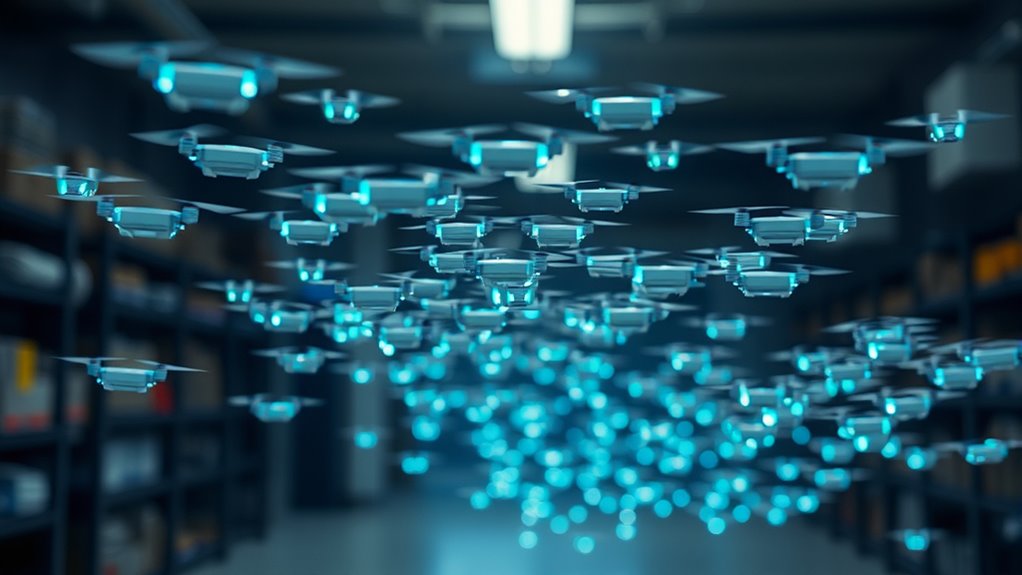AI dramatically enhances swarm robotics by enabling autonomous, adaptive, and decentralized behaviors that mimic natural systems like bird flocks and ant colonies. It improves navigation, coordination, and resource management, allowing robots to operate efficiently without central control. AI also supports real-time decision-making, self-organization, and resilience in changing environments. If you continue exploring, you’ll discover how these innovations are shaping the future of robotic swarms across diverse applications.
Key Takeaways
- AI enables autonomous, self-organizing behaviors, enhancing the adaptability and resilience of swarm robotic systems.
- Decentralized AI control allows robots to coordinate effectively without central oversight.
- Advanced navigation and path planning algorithms optimize routes and reduce human intervention.
- AI-driven communication streamlines task allocation and real-time environmental response within the swarm.
- Resource management and predictive maintenance improve efficiency, system health, and scalability of swarm operations.

Artificial Intelligence has revolutionized swarm robotics by enabling autonomous, efficient, and adaptable collective behaviors. When you incorporate AI into swarm systems, you empower robots to operate cohesively without direct human control. AI-driven algorithms improve navigation, coordination, and enhancement, allowing each robot to make decisions based on real-time data. By mimicking biological systems, such as ant colonies or bird flocks, AI helps robots develop natural, efficient behaviors for complex tasks. This bio-inspired approach results in swarms that adapt swiftly to environmental changes, making them more resilient and versatile.
Control systems built with AI are fundamental to this advancement. These systems facilitate decentralized control, meaning each robot can operate independently while contributing to a common goal. This setup reduces reliance on a central controller, increasing robustness and scalability. AI enables you to design control architectures that allow robots to self-organize, share information, and adapt behaviors on the fly. As a result, the swarm functions seamlessly even in unpredictable or dynamic conditions, providing a level of flexibility that traditional control methods can’t match. Decentralized control systems Additionally, advancements in AI allow for more sophisticated decision-making processes, further enhancing system robustness. Incorporating feedback loops enables continuous improvement of the swarm’s collective behavior through real-time adjustments. Real-time data processing further enhances this process by allowing rapid responses to environment changes.
AI-driven control systems enable decentralized, adaptable, and resilient swarm behaviors without relying on a central controller.
Navigation and path planning see significant improvements through AI techniques. Reinforcement learning helps your robots discover enhancement routes by rewarding successful movements, while evolutive computing evolves strategies over generations to find better solutions. Graph neural networks analyze complex environments to predict and optimize paths, especially when obstacles or changing terrains are involved. Adaptive path planning allows swarms to adjust their routes instantly based on new information, ensuring they reach their targets efficiently. This combination of AI methods helps your robots navigate intricate settings with minimal human input, saving time and energy.
Coordination and communication within the swarm are also enhanced by AI. It streamlines how robots share information and assign tasks, even without a central authority. Decentralized communication strategies ensure that each robot can communicate locally while still contributing to the collective effort. Real-time adaptation enables the swarm to respond immediately to environmental shifts or unforeseen obstacles, maintaining operational effectiveness. Self-organization, driven by AI, allows the swarm to autonomously reorganize itself, distributing tasks dynamically and optimizing overall performance. Moreover, AI techniques are increasingly used to improve system scalability, enabling larger and more complex swarms to operate efficiently.
AI’s influence extends to optimizing resources and maintaining system health. Techniques like predictive maintenance forecast when robots need repairs, reducing downtime. AI manages large-scale operations involving hundreds or thousands of robots, ensuring efficiency at every level. It also facilitates dynamic adaptation, allowing swarms to reconfigure in response to new challenges or opportunities on the fly. In all these ways, AI dramatically enhances the capabilities of swarm robotics, making them more autonomous, efficient, and adaptable for a wide range of applications.
Frequently Asked Questions
How Does AI Improve Decision-Making in Swarm Robotics?
You wonder how AI improves decision-making in swarm robotics. AI enables your robots to make real-time tactical decisions, like dividing into squads or reallocating resources based on environmental data. It enhances navigation, coordination, and fault detection, allowing your swarm to adapt quickly to changing conditions. With AI, your robots operate more efficiently, recover from errors seamlessly, and maintain mission continuity, even in unpredictable or critical environments.
What Are Ethical Concerns With Ai-Driven Swarm Systems?
Imagine deploying a swarm of AI robots, but suddenly, ethical concerns emerge that could threaten your project. You face dilemmas like accountability when things go wrong, privacy risks from data collection, and biases that skew fairness. These issues challenge trust, safety, and sustainability. You must navigate complex decision-making, guarantee transparency, and uphold societal values to prevent unintended harm and maintain responsible innovation in your swarm system.
Can AI Enable Adaptive Behaviors in Unpredictable Environments?
Yes, AI can enable adaptive behaviors in unpredictable environments. You can program swarm robots to learn from their experiences, reconfigure their actions, and communicate locally for collective decision-making. This decentralized approach allows each robot to respond to changes dynamically, just like biological systems. As a result, your swarm can self-organize, handle unforeseen challenges, and maintain efficiency without human intervention, making them highly effective in complex, ever-changing settings.
How Scalable Are AI Algorithms for Large Swarms?
You might wonder how scalable AI algorithms are for large swarms. They are quite scalable thanks to decentralized structures and local interactions, which reduce communication and control bottlenecks. Techniques like Particle Swarm Optimization, Reinforcement Learning, and Genetic Algorithms allow your swarm to grow without losing efficiency or robustness. This scalability enables your system to handle complex tasks, adapt to changes, and maintain performance even when facing failures or expanding in size.
What Are the Limitations of Current AI in Swarm Robotics?
You might be surprised to learn that simulating large swarms demands immense computational resources, often making real-time decisions difficult. Current AI in swarm robotics faces significant limitations: scalability struggles due to hardware constraints, reduced flexibility in dynamic environments, and challenges with fault tolerance and self-organization. Algorithms often require manual tuning, and widespread real-world deployment remains limited. These issues hinder the full potential of AI to achieve robust, adaptable, and scalable swarm systems.
Conclusion
As you witness AI’s touch on swarm robotics, it’s like watching a symphony come alive—each robot a note, harmonizing seamlessly. AI fuels their dance, guiding countless tiny agents to act as one, like a flock in perfect formation. This fusion sparks a future where technology and nature entwine, creating a rhythm of innovation. Embrace this wave, for with AI, your swarm’s potential blossoms into a vibrant, unstoppable chorus of progress.










